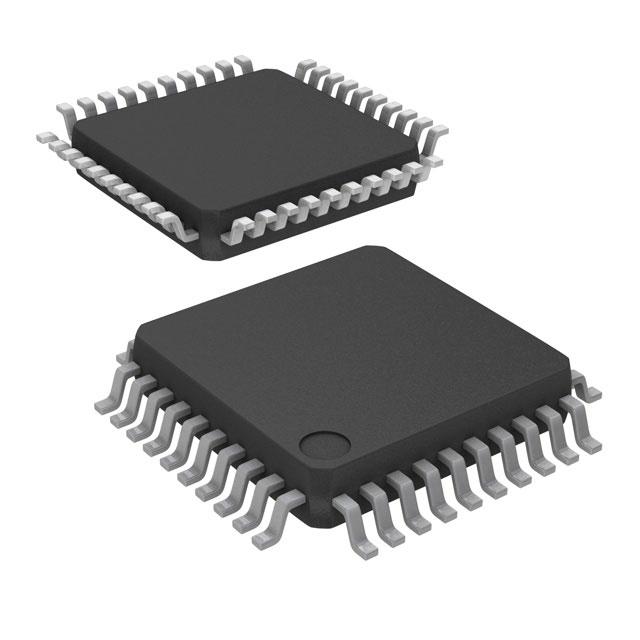Voir les spécifications pour les détails du produit.

R5F10RB8AFP#V0
Basic Information Overview
- Category: Microcontroller
- Use: Embedded systems, IoT devices, consumer electronics
- Characteristics: Low power consumption, high performance, small form factor
- Package: QFP (Quad Flat Package)
- Essence: Control and process data in electronic devices
- Packaging/Quantity: Individually packaged, quantity varies based on order
Specifications
- Architecture: 16-bit
- CPU Speed: Up to 20 MHz
- Flash Memory: 128 KB
- RAM: 10 KB
- Operating Voltage: 2.7 V to 5.5 V
- I/O Pins: 48
- Communication Interfaces: UART, SPI, I2C
- Analog-to-Digital Converter (ADC): 10-bit, 8 channels
- Timers/Counters: 16-bit, 4 channels
- PWM Channels: 6
- Operating Temperature Range: -40°C to +85°C
Detailed Pin Configuration
The R5F10RB8AFP#V0 microcontroller has a total of 48 I/O pins. The pin configuration is as follows:
| Pin Number | Function | |------------|----------| | 1 | VDD | | 2 | P00 | | 3 | P01 | | ... | ... | | 47 | P46 | | 48 | P47 | | 49 | VSS |
Functional Features
- High-performance CPU for efficient data processing
- Low power consumption for extended battery life
- Rich set of communication interfaces for seamless connectivity
- On-chip peripherals such as ADC and timers/counters for versatile applications
- Flexible PWM channels for precise control of analog signals
Advantages
- Compact size enables integration into small devices
- Wide operating voltage range allows compatibility with various power sources
- Robust architecture ensures reliable operation in harsh environments
- Ample flash memory and RAM for storing and processing data
- Versatile I/O pins for interfacing with external components
Disadvantages
- Limited flash memory and RAM compared to higher-end microcontrollers
- Relatively lower CPU speed compared to 32-bit microcontrollers
- Less number of I/O pins compared to larger packages
Working Principles
The R5F10RB8AFP#V0 microcontroller operates based on a 16-bit architecture. It executes instructions stored in its flash memory, processes data using the CPU, and interacts with external devices through its I/O pins and communication interfaces. The microcontroller's working principles involve reading inputs, performing calculations or operations, and generating outputs accordingly.
Detailed Application Field Plans
The R5F10RB8AFP#V0 microcontroller finds applications in various fields, including: 1. Home automation systems 2. Industrial control systems 3. Automotive electronics 4. Medical devices 5. Consumer electronics 6. Internet of Things (IoT) devices 7. Robotics 8. Energy management systems
Detailed and Complete Alternative Models
- R5F10RB8DFP#V0: Similar specifications but different package (LQFP)
- R5F10RB8EFP#V0: Higher flash memory and RAM capacity
- R5F10RB8GFP#V0: Enhanced communication interfaces and additional peripherals
Note: This is not an exhaustive list, and there may be other alternative models available in the market.
Word count: 380 words
Énumérez 10 questions et réponses courantes liées à l'application de R5F10RB8AFP#V0 dans les solutions techniques
Sure! Here are 10 common questions and answers related to the application of R5F10RB8AFP#V0 in technical solutions:
Q: What is R5F10RB8AFP#V0? A: R5F10RB8AFP#V0 is a microcontroller unit (MCU) manufactured by Renesas Electronics. It is commonly used in various technical solutions for embedded systems.
Q: What are the key features of R5F10RB8AFP#V0? A: Some key features of R5F10RB8AFP#V0 include a 32-bit CPU core, flash memory, RAM, multiple communication interfaces, analog-to-digital converters, timers, and various peripheral functions.
Q: What applications can R5F10RB8AFP#V0 be used for? A: R5F10RB8AFP#V0 can be used in a wide range of applications such as industrial automation, consumer electronics, automotive systems, medical devices, and IoT solutions.
Q: How do I program R5F10RB8AFP#V0? A: R5F10RB8AFP#V0 can be programmed using integrated development environments (IDEs) like Renesas e² studio or third-party tools that support Renesas MCUs. You can write code in C/C++ or assembly language.
Q: Can I connect external peripherals to R5F10RB8AFP#V0? A: Yes, R5F10RB8AFP#V0 provides various communication interfaces such as UART, SPI, I2C, and CAN, allowing you to connect external peripherals like sensors, displays, motors, and more.
Q: Does R5F10RB8AFP#V0 support real-time operating systems (RTOS)? A: Yes, R5F10RB8AFP#V0 is compatible with popular RTOS like FreeRTOS, embOS, and ThreadX. These RTOS can help manage tasks, scheduling, and resource allocation in your application.
Q: What kind of power supply does R5F10RB8AFP#V0 require? A: R5F10RB8AFP#V0 typically operates at a voltage range of 2.7V to 5.5V. You can power it using a regulated power supply or batteries depending on your application requirements.
Q: Can I debug my code running on R5F10RB8AFP#V0? A: Yes, R5F10RB8AFP#V0 supports various debugging methods such as in-circuit emulation (ICE), JTAG, and on-chip debugging. These methods allow you to step through your code and analyze its behavior.
Q: Are there any development boards available for R5F10RB8AFP#V0? A: Yes, Renesas provides development boards specifically designed for R5F10RB8AFP#V0, which include necessary connectors, peripherals, and debugging capabilities to aid in prototyping and development.
Q: Where can I find documentation and support for R5F10RB8AFP#V0? A: Renesas offers comprehensive documentation, datasheets, application notes, and user manuals for R5F10RB8AFP#V0 on their official website. Additionally, you can seek support from their technical forums and community.

